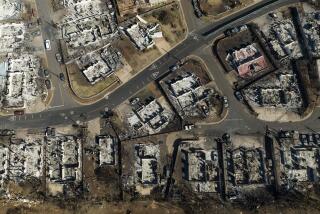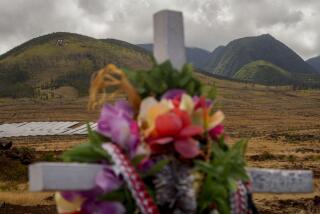Hawaii’s Kilauea volcano a year later: a low-key ceremony, a much bigger crater
- Share via
One year ago this week, scientists on the island of Hawaii were worried. They were seeing troubling changes with the active Kilauea Volcano. Although unnoticeable to visitors to Hawaii Volcanoes National Park, many of whom traveled to the island specifically to view the cauldron of red-hot lava, big changes were afoot.
On May 4, 2018, the fears of those scientists at the U.S. Geological Survey Hawaiian Volcano Observatory were realized as a magnitude 6.9 earthquake rocked the region, setting in motion events that fundamentally changed the park, and the surrounding area.
Lava poured from several fissures, and rivers of molten rock obliterated hundreds of homes in the Puna community near the southeast shore of the island.
As the eruptions and earthquakes — 60,000 in all — continued, most of the national park closed from May 11 through Sept. 22, scaring away visitors from Hawaii Island, revenue that is a lifeblood for the area.
Flights to Kauai’s North Shore restart, after more than two decades »
A year later, Pele, in Hawaiian tradition, the goddess of fire, has returned to the bowels of the earth. Park officials say the observance of those events a year ago will be noticeably low-key. The only event planned to mark the anniversary is a 30-minute presentation at 7 p.m. May 9. at the Kilauea Visitor Center. Admission is free, but park entrance fees apply.
“Seven hundred homes were destroyed,” said park spokeswoman Jessica Ferracane. “Two thousand people were displaced. This is nothing to celebrate.”
Changing the face of Hawaii Island
Visitors arriving at the edge of the Halemaumau Crater now witness startling evidence of the forever-changed landscape. Gone is the lava lake that bubbled for years and illuminated the night sky. Seismic activity caused that lava to be sucked underground as the crater, a massive hold in the ground, nearly doubled in size -- to about three miles by two miles.
New cracks in the earth’s surface, scientists call them fissures, appeared nearby, dramatically spewing molten lava into the air and creating destructive rivers of red. “I get asked, ‘Where’s the volcano?’ ” ranger Jozie Acasio told a group of visitors during an April 19 presentation at the easily accessed Steam Vents overlook near the rim of the Halemaumau crater.
Because Kilauea is a relatively young volcano, it is mostly flat; the customary peak takes millenniums to form, Acasio said.
“We’re a different type of volcano than Mount St. Helens or Mount Rainier,” she said of the two Washington state volcanoes. Mount St. Helens erupted in May 18, 1980, killing 57 people, causing a billion dollars in damage and wiping out 200 square miles of terrain. Rainier last erupted in 1894 and is considered dormant. No one died during last year’s eruption in Hawaii.
Most of the park has reopened to the public, including the two-mile round-trip hike along Devastation Trail to Keanakakoi Overlook, considered the best spot from which to peer into Halemaumau’s giant yawn.
Some areas remain closed because of safety concerns. For example, much of Crater Rim Drive, which encircled Halemaumau, is not off-limits. A part of the road plunged 200 feet into the crater as it expanded in size.
The popular overlook at the Jaggar Museum, and the museum itself, which contained geologic and cultural artifacts, are likely lost. The quakes damaged the building and the adjoining terrace. They now sit perilously close to the rim.
Some exhibits rescued from the museum are now displayed at Pahoa Lava Zone Museum, about 32 miles from the national park.
Although the bubbling, flowing red lava has disappeared, it will someday return.
“Kīlauea remains an active volcano, and it will erupt again,” the USGS said in an April 16 statement.
Info: Hawaii Volcanoes National Park
More to Read
Sign up for The Wild
We’ll help you find the best places to hike, bike and run, as well as the perfect silent spots for meditation and yoga.
You may occasionally receive promotional content from the Los Angeles Times.






